The Deep (aquarium)

The Deep is a public aquarium situated at Sammy's Point, at the confluence of the River Hull and the Humber Estuary in Hull, England. It opened in March 2002. Billed as "the world's only submarium", the exhibits contain thousands of sea creatures (including seven species of shark), 2,500,000 litres (550,000 imp gal) of water and 87 tonnes (86 long tons) of salt housed in a building designed by Terry Farrell and built as part of the UK National Lottery's Millennium Commission project. The Deep is also a landmark centre for marine research. A team of aquarists look after the animals in The Deep's collection as well as carrying out research into the marine environment. In 2013, the aquarium was voted the best family place to visit in Hull. The Deep is a charitable public aquarium dedicated to increasing people's enjoyment and understanding of the world's oceans.
Excerpt from the Wikipedia article The Deep (aquarium) (License: CC BY-SA 3.0, Authors, Images).The Deep (aquarium)
Millennium Bridge, Hull Old Town
Geographical coordinates (GPS) Address Website External links Nearby Places Show on map
Geographical coordinates (GPS)
| Latitude | Longitude |
|---|---|
| N 53.738611111111 ° | E -0.33055555555556 ° |
Address
The Deep
Millennium Bridge
HU1 4DP Hull, Old Town
England, United Kingdom
Open on Google Maps










